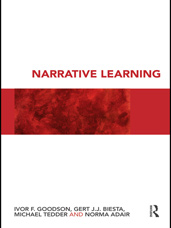Narrative Learning
Towards a Theory of Narrative Learning
Narrative quality, narrative learning, and the question of action
Narrative learning can be evidenced in the substance of the narrative but also in the act of narration. Narrative learning, as we have said in the introduction chapter, is therefore not solely learning from the narrative; it is also the learning that goes on in the act of narration and in the ongoing construction of a life story. Within the cases we have presented in this book there are already important differences in relation to this. Some stories are short, descriptive, and, in a sense, finished. Other stories are more elaborate and contain elements of analysis and evaluation. Whereas the first kind of stories gives the impression that they are more scripted and less the result of learning – the working and reworking the story of one’s life in response to experiences and on the basis of reflections – the second kind of stories seems to provide evidence of narrative learning, that is of learning done through the construction and reconstruction of the story of one’s life. But such stories can have a finished quality as well. They are more the products of past narrative learning than that they are evidence of ongoing narrative learning. This is what, in our view, unites the case of John Peel with that of Diogenes. Although the stories they have to tell about their lives are significantly different in narrative quality – that is, in terms, of intensity, description/ analysis, and the presence of a plot – the stories themselves are more closed than open; they have a more finished quality. Nonetheless, as we have seen, these stories are important ‘reference points’ for their achievement of a degree of agency in their lives – they are not, in other words, without action potential. John Peel helps us to see how a ‘finished’ life story can be very functional if it ‘fits’ with the context, but loses its efficacy when circumstances begin to change and the fit is no longer there. With Diogenes it is, perhaps, more the strength of the values and convictions that were central in his life story that allowed him to operate effectively under changing circumstances, albeit that new circumstances remained ‘measured’ against a set of values that was developed in the past. Closed life stories, to put it differently, are therefore not without action potential although the relative inflexibility of such stories makes their utility as a tool to engage with changing circumstances sometimes more limited. In this sense we can think of our narrative resources as a kind of ‘narrative capital’ (Goodson 2006) – the narrative ‘repertoire’ that can assist us in navigating change and transition in our lives.
